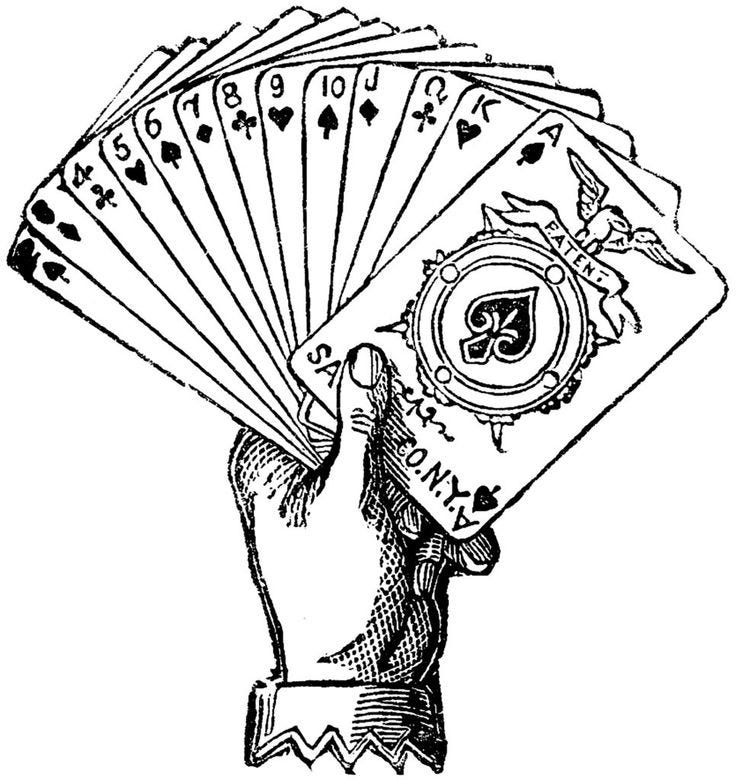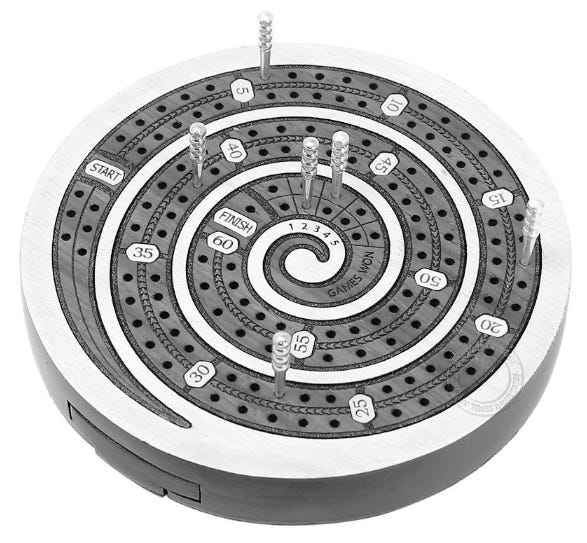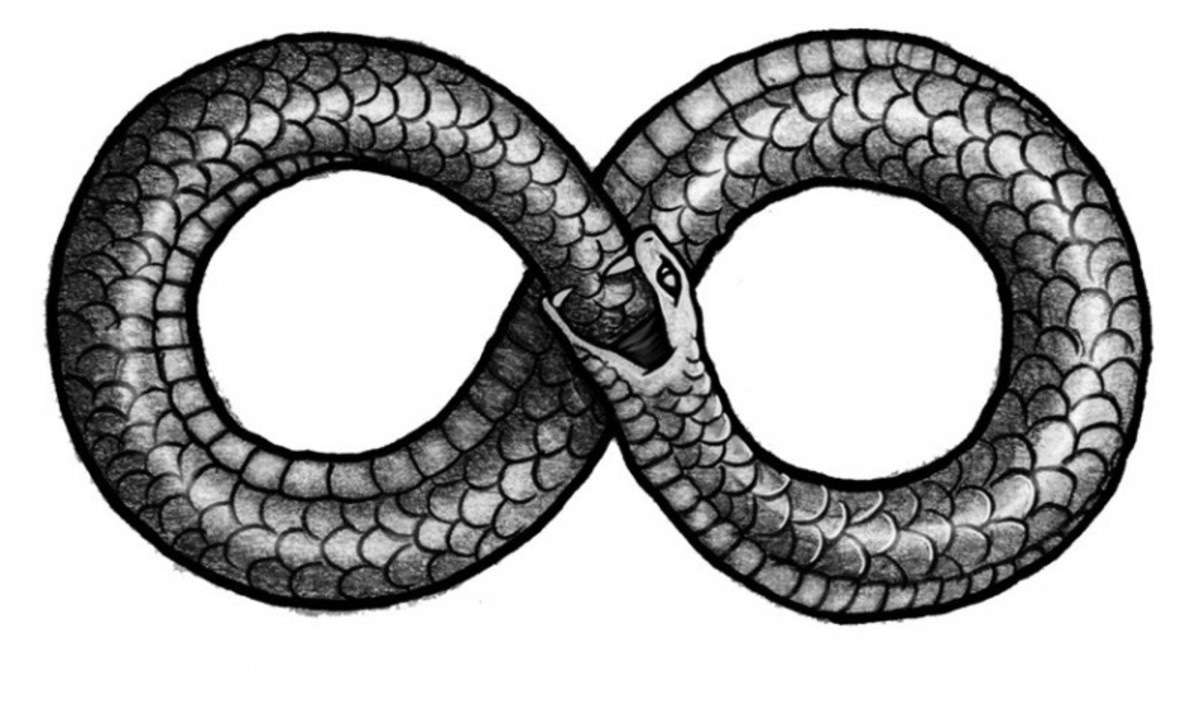Enumerating Cribbage
Nibs, Nobs, Skunks, and Muggins
Your grandmother’s favorite card game1 is rich with statistical and mathematical problems. Combinatorics is embedded in scoring2, and that’s only the beginning. Let’s talk big numbers: the permutations, the combinations, the nitty gritty googology.
Fifteen Two: Hands
During the “show” stage (this house calls it the “count”) of cribbage, players3 tally up points based on combinations formed between the four cards in their own hand and the one cut card that both players have in common. This is a very comprehensive article on the combinatorics and general likelihoods of these cribbage hands. The math works out to 52 choose 4 to account for all possible four-card hands, multiplied by 48 to account for the cut card (and its unique position), or 12,994,800 distinct score-able hands. This is great, but it almost entirely ignores the opponent by speaking only to “the show” when enumerating possible hands. This isn’t just an oversight of net points4 or throwing, but a flawed perspective on the base unit of cribbage identity. It leaves out the very dynamic and for my money, most genius5 mechanism in cribbage: pegging. You make choices and score points based on your opponent’s cards. The quantum of possibility, I’d argue, is double-sided.6
Fifteen Four: Rounds
A single shuffle, deal, throw, cut, peg, show, and crib is commonly referred to as a “hand”, but that word is a bit overloaded after that last section. I’ll refer to this whole cycle as a “round” from now on so we can better examine the possible states of play cribbage can have. I’m trying to be precise with language here because (at least in theory) a given round should carry out the same way every time between two players if they are both playing optimally. Accounting for all of the possible rounds admittedly explodes the combinatorics problem to an unwieldy 15.2 quadrillion7. What do we do with all of that possibility?
Fifteen Six: Choices
There are two opportunities that cribbage players have to exercise choice over the game. The first is when they “throw” two cards to the crib, reducing the cards they each have in hand from six to four. For any six-card deal, there are 158 ways to discard two of them. The second is during pegging, when cards are played once each, alternating between the players when possible until all eight are face up. The possibilities of pegging are a little more complicated because of the cap at 31, but you'll never have more than 249 ways you can peg.
So for every possible round, each player has 360 possible choices to consider, some nested within others. There are good pegging hands, good counting/show hands, good cards to throw to yourself, good cards to throw to your opponent. Even casual players pick up on the dynamics that this series of connected choices have, but (because of this massive decision space) most are constrained to heuristics or proverbs. Good players consider both their own choices and their opponents when throwing and pegging, but a perfect player would consider it all.
If we want a quick back-of-the-envelope number for “it all” here10, we get up to 80 sextillion11. That would contain every terrible deal, every last minute comeback, every 19-point crib, every perfect choice, every awful choice, and everything in between. If you can believe it, that's not even (to me) what makes cribbage strategically interesting.
Fifteen Eight: Recursion
The earliest of the cribbage heuristics that a player is likely to pick up on is relevant to pegging: don’t lead with a ten. During pegging and during the count, having a combination of cards that add to 15 is worth two points. Since 10s and face cards both contribute 10 to this summation, 10s are the most common card12 through the course of play. This makes 5s highly valuable in essentially any context. If a player is dealt a 5, they are likely to keep it, especially if they don’t have a claim on the crib. If you lead with a 10, you're likely gifting your opponent an easy "fifteen for two".
What I just described is not a trivial sequence of strategic deductions, but our weird little monkey brains are very good at finding these shortcuts and patterns, especially after a lot of repetition. There are increasingly meta ways to strategize on display here:
Throw based on the maximum number of expected points, and observe that the opponent will play in alignment with this strategy.
Observe that the rules distribute value to different cards non-uniformly, causing the actions in (1) to increase the likelihood of certain cards being in the opponent’s hand during pegging.
Peg in a way that minimizes the opponent’s points, incorporating the augmented likelihood intuited from (2).
So returning to the concept of a round, how does a player make their choices? They maximize the expected value of net points scored throughout the round, while assuming the other player is employing that same strategy. The second part of that sentence is the key to the recursive loop, since it fundamentally changes the prevalence of certain cards your opponents pegs with. Pegging strategy changes throwing strategy, which changes card prevalence during pegging, which changes pegging strategy.
In my research so far, I’ve found a lot of resources focused on pegging strategy for net points, throwing strategy for net points shown, and (empirical) likelihood augmentation, but nothing that incorporates all of these concepts into a recursive holistic Theory of Cribbage. If you know of such work, tell me! I’d love to read it. Otherwise I’ll be waiting for time to more formally mathemat-ize13 these concepts, or the forthcoming AI Singularity to search through 23 digits worth of cribbage scenarios for me.
One of the many reasons it’s a difficult game to teach to the uninitiated. If you’re one of those and curious, good luck!
Here and everywhere else in this post, I’ll be talking about two player 6-card cribbage.
Since one player is always throwing two cards to the other, it’s important to balance the points in the hand they keep with the hand that forms from the discarded leftovers (the crib).
This is high praise coming from me. Cribbage is downright bursting with genius design.
I think this distinction is meaningful and material, so bear with me on this extended sidebar (if you’re curious). It goes back to what you consider an identical hand. I’m not arguing that any card game with opponents and interactions actually includes all players’ hands, but that pegging adds decisions of a kind that distinguish a given player’s otherwise identical 5-card hands. Take for example (ignoring suit and cut here for simplicity and lack of relevance), the case where I hold 4-5-5-6 in my hand. The case where my opponent leads pegging with a 10 is distinct from the one where they lead with a 3 in a very meaningful way. The first six cards they are dealt lead them down a path that augments not only the value of my hand (as the cut trivially does, without any choice or action), but the plays I make. In my mind, those choices distinguish hands that otherwise contain the same cards for one player. I don’t even want to get into endgame scenarios where the number of points left to win are important to the kind of risk tolerance or aversion each player will have, so in some sense, I’m simplifying!
(52 choose 6) * (46 choose 6) * 40 * 2. This is of course the absolute ceiling for cribbage scenarios if we ignore the points already scored. Both players are dealt 6 cards, there is a cut card from the remainder, and either player can be the dealer (which materially impacts throwing strategy). A perfect player would consider the net value of showing and pegging when they throw, and be responsive to each played card as they are revealed during pegging by their opponent.
6 choose 2. Or, if you prefer, 6 choose 4. Math works because it has to.
“It all“ being all possible choices stemming from all possible rounds in all possible scoring states. If you wanted to “solve” cribbage with completeness, this would be your worst-case search space. There are simplifications to be made for hands with no shot at a flush, and some trimming around lack-of-choice in pegging, so the real number would be much smaller, but probably still unmanageable in human time.
I decided to un-simplify and add the state of the board back in, which amounts to 121 possible playable spaces for each player. I did not account for matches/series of play, but constrained the unit of competition to a single game.
Each card is still literally distinct, so you can’t make a pair with 10-J for example, but the summation scoring that cribbage uses flattens out 10-J-Q-K.
Coined and minted.





